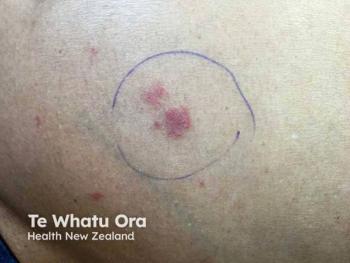
Gaps in Management of AD SOC Patients
Drs Angela Lamb, Omar Noor, and Neal Bhatia share what they consider to be the biggest gaps in care for patients with SOC: patient/provider education, building trust, and appropriate diagnosis of AD.
Episodes in this series

Neal Bhatia, MD: I’m going to finish up with some gaps, and we’ve had a good overview of how to address some of the patient stereotypes and concerns about phobia. Angela, I’ll ask you, what kind of gaps remain in talking to skin of color patients about treating eczema and where we sit? What kind of things are we still working on?
Angela Lamb, MD: As far as the gaps, I think one is patient education portals. I think the pharmaceutical companies have done an amazing job of educating patients and having patient resources, but I think we can probably do better. I know the National Eczema Association has some resources, but I think vetting those, making sure they make sense to patients, is important. Making sure they’re written in a way that’s digestible for them, perhaps doing more with videos. Now everybody has TikTok and Instagram, and I don’t want to demonize those platforms, but perhaps we could find a way to merge with them and educate our patients in that way. So aligning perhaps with those platforms, or getting the information out there and meeting the patients where they are, I think that’s really important.
I also think doing more of what’s already being done. When I watch television, which my youngest child is 4 months old, so I don’t watch that much television anymore, but I think that the ad campaigns are reflecting society. They’re doing a much better job of that, so I think that also builds trust. Omar hit on something that I think is key, that patients want to feel like the medication is for them, or taking them into account, and I think the marketing companies are getting that. That aligns with the pharmaceutical companies, and I think that’s making a huge impact. So doing more of that is really important.
Then the last point is that this is an incredibly exciting time for atopic dermatitis. I’ve been a physician now 15 years, and I’ve never had this many medications to use for patients. We were stuck for a long time. People in my office begged me to give them a steroid injection for the fifth time, they came from some other doctor, and having those hard conversations. Now I feel so empowered that there are some great things we can offer folks with relatively low side effect profiles, and different categories of medications too. I think it’s an incredibly exciting time. I think we have filled a lot of those gaps.
Neal Bhatia, MD: Yes, and that’s important, especially from the patient education side, the awareness side, getting them through some of the stereotypes, but also getting them off the ledge a bit in terms of getting aggressive with their disease. Omar, I’ll ask you the same thing about gaps, but it take from the standpoint of the dermatologist, the allergist, the pediatrician. What are their gaps in terms of not just the diagnosis but moving forward with treatment?
Omar Noor, MD, FAAD: I think the biggest gap, which we know still exists today, and which is definitely being addressed by this awareness campaign, and I agree with Angela that the discussion around awareness is important in getting more patients in the door. But we know that darker skin types are being diagnosed at a slower rate. There is a delay in diagnosis because there is a delay in education around the signs of atopic dermatitis in darker skin types. The discussion or the biggest gap is to make sure that if someone has atopic dermatitis, they’re identified early and treated appropriately. This definitely applies to dermatologists, allergists, but also primary care doctors, pediatricians, internists, even pulmonologists, who may be seeing a patient for asthma who has concomitant atopic dermatitis as a comorbidity, but maybe is not addressing it because they are not sure what it is. They’re not seeing the red rash that they’re expecting with atopic dermatitis. Angela mentioned, atopic dermatitis in darker skin types tends to be extensor, on the back of the arms, more papulae. Whereas they’re used to seeing it in their Caucasian patients as being a confluent rash on the inside of their arm. So making sure that patients are identified appropriately and then treated appropriately. So education, education, education, and communication.
Neal Bhatia, MD: That’s all excellent. If I had to identify one gap, it would be management of itch in skin of color, in addition to treating what we’ve talked about. All these therapeutic options have been great. We’ve talked about all the access to them, and I would still emphasize moisturizing and cleansing, just like brushing our teeth. We do that to stay away from problems and prevent problems rather than treat them. It’s the same thing with itch, intercepting the itch at the first sign of it. We have some good things coming for management of itch, and I think we can get those into the wheelhouse as well. This was great you two, I think we had a very comprehensive overview.
Angela Lamb, MD: This was fantastic.
Neal Bhatia, MD: It was good to hear all the perspectives and how we can learn a little on how to get patients over the hump, so I think this is good. Dr Angela Lamb, thank you very much.
Angela Lamb, MD: Thank you.
Neal Bhatia, MD: Dr Omar Noor, thank you very much. This is Dr Neal Bhatia, we’ll say thanks and we’ll see you again next time.
Transcript edited for clarity
Newsletter
Like what you’re reading? Subscribe to Dermatology Times for weekly updates on therapies, innovations, and real-world practice tips.






















